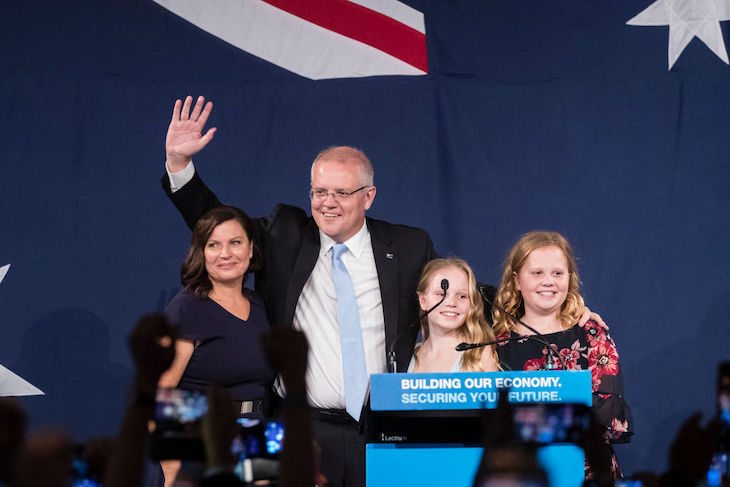‘I have always believed in miracles,’ Scott Morrison beamed. Australia’s first Pentecostal prime minister was addressing a victory rally after an upset in Saturday’s federal election. Throughout the campaign, pollsters and pundits had been as one: the Coalition (a centre-right alliance between Morrison’s Liberal Party and the agrarian National Party) was finished and Labor was headed into government after six years in opposition. Morrison was the fractious Coalition’s third prime minister since 2013, his ministry was divided over climate change and Labor leader Bill Shorten had tapped into public anger at the banks and the top end of town.
Then they voted. One by one, marginal Coalition seats held firm and suddenly the electoral map’s red patches began bursting into Coalition blue. Labor stalwarts packed into TV studios to cheer their party back into power were abruptly called on to deliver stunned eulogies. Although the preferential voting system, large postal vote and Australia’s vast rural electorates mean no seats have been formally declared, the Australian Electoral Commission has the Coalition ahead in 78 seats (76 are needed for a majority) and Labor in 67, with minor parties and independents bagging the rest. Labor’s right-winger Shorten is going and left-winger, veteran progressive Anthony Albanese is the leading contender to replace him.
No one saw this coming. The three years of polling since the last election produced exactly two surveys putting the Coalition ahead on the two-party-preference vote, the most recent of those in mid-2017. Morrison came home with a wet sail and has left Australian pollsters with much soul-searching to do. The turnaround is being compared to Donald Trump’s unforeseen triumph in 2016 and the Tories’ surprise win in 2015.
A more fitting analogue is the 1993 election Down Under, when Paul Keating defied every political prognosticator to secure Labor an historic fifth consecutive term in office. He did it by turning Fightback! — a 650-page Thatcherite fiscal prospectus — against its author, Liberal leader and economist John Hewson. Keating honed in on a proposed goods and services tax and soon Hewson was struggling to explain on TV interviews whether his tax would apply to bin liners and birthday cakes. Keating choked Hewson with his own policies.
Morrison did much the same to Shorten, who had outlined an ambitious tax policy of scrapping negative gearing and cutting the capital gains discount on investment properties while ending cash rebates for excess dividend imputation credits. With climate change one of the major talking points of the campaign, Labor proposed an emissions-cutting national energy guarantee (a former Coalition policy that got Morrison’s predecessor Malcolm Turnbull ousted) and a rapid reduction in reliance on coal. Morrison campaigned hard against policies he warned would sock voters with higher taxes and put Queensland coal workers out of jobs. Attack ads branded Shorten ‘the Bill Australia can’t afford’.
Morrison pitched himself as a world-weary Aussie ‘battler’ dad and his opponent a hostage to well-heeled green-left activists who’d never had to worry about putting food on the table. He couldn’t make the voters love his mad, warring party but he could convince them this dumpy, slightly bumbling, suburban bloke with his open-necked shirt and Cronulla Sharks baseball cap could be trusted more than Shorten, an ex-union fixer instrumental in toppling two Labor prime ministers.
Aussies rewarded a banal, policy-lite offering and told the campaign that gave them chapter and verse on spending and costings to shove off. Democracy’s under-appreciated flaw is that the voters can be absolute bastards. Many of the blue collar workers who spurned Labor would have benefited from its promised tax cuts for the low-paid. Shorten waved their boss’s credit card at them but Morrison captured their mood – put-upon, yet sceptical; not happy, but not ready for a change. This was the great Australian shrug.
Even if every outstanding seat falls in his favour, Morrison will head a precarious government riven by ideological strife, but the voters have signalled that they don’t care about that. Disunity is no longer death. Punch-drunk Liberals have christened Morrison ‘the Messiah from the Shire’. Their biggest setback was Tony Abbott’s defeat in Warringah, though the seat will be missed more than its ousted incumbent. Abbott, a US-style conservative, led his party to power in a 2013 landslide but was rolled by his archenemy, moderate Malcolm Turnbull, in a party room coup in 2015. He dedicated himself to undermining Turnbull and is seen as the architect of Turnbull’s own downfall last year. ‘I’d rather be a loser than a quitter,’ Abbott zinged Turnbull in his Saturday concession speech, but to many inside his own party he is a wrecker. His failure to stand aside cost the Liberals a seat that might prove essential to clinching a working majority.
Australia 2019 is not a precise re-run of America 2016, but there is an echo: educated professional voters continued their drift leftwards while working and lower-middle class electors softened on right-wing parties. Warringah has been an electoral division since 1922 and has always voted conservative, until Saturday, when Abbott was booted by centrist independent Zali Steggall. Abbott didn’t change but, over the years, Warringah did. 42 per cent of voters there are graduates, compared to an Australia-wide 22 per cent; the median weekly family income is $2,989, more than a thousand dollars higher than the $1,734 taken home in the country at large. Australia voted 62 per cent in favour of same-sex marriage in the 2017 postal plebiscite; Warringah was 75 per cent Yes. Climate change was a priority for locals; their outgoing MP said ‘the climate change science is far from settled’. Culture warrior Abbott spent a career drawing battle lines until eventually the enemy was his own voters.
Scott Morrison won an unwinnable election and lost his own party’s bogeyman in one fell swoop. No wonder he believes in miracles.







Comments